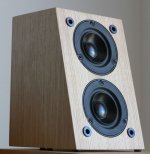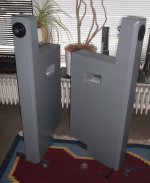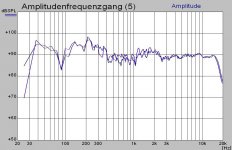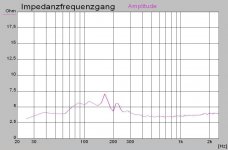From the document i posted earlier it should be clear that i meant 6dB only below the turn over point of the filter.
Without that statement, the whole post doesn't make any sense, does it?
I well understand 1.5 way.
I strongly doubt that since you've already posted the same wrong things several times. And you've already claimed also several times they would be correct. I thought it would be time to make a point and state that you are, in fact, are not correct.
In the series configuration, the extra efficiency of 2 drivers is countered (close to exactly) by the decreased power at LF due to the system impedance doubling… half the power going in and that now split between 2 drivers. So each driver gettin a forth the power, so one can play 6dB louder before running into the same power level limits as a single driver )since those limits are almost always in the bass).
That is absolutely not the case of a 1.5 way system. That confirms you don't have a grasp of how it's working or what are the limtis of a fullrange driver. The fullrange driver will suffer from intermodulation distortion A LOT SOONER than it goes into the excursion limit. And that distortion limits it and that's why you don't get 'more' out of a 1.5 system. The excursion (yes, that's the reason of the IMD (intermodulation distortion)) defines the limt in this case, not the cone surface or power limt. And the 2nd driver does NOT reduce the excursion at all. Please, learn the basics before you talk more about that topc.
Without that statement, the whole post doesn't make any sense, does it?
Implied by my earlier post and that we are talking about a 1.5 system.
I strongly doubt that since
It seems to me you do not understand from your posting of erroneous information.
That is absolutely not the case of a 1.5 way system.
You seem to be limiting yourself to a parallel configuation, where i clearly state that i am talking about the series configuration.
dave
Implied by my earlier post and that we are talking about a 1.5 system.
Yes, i was talking about exact that thing.
It seems to me you do not understand from your posting of erroneous information.
You mean erroneous? No, I think my post was pretty unmistakable. If that was unclear to you, you probably need some explanation of the underlaying physics?
You seem to be limiting yourself to a parallel configuation, where i clearly state that i am talking about the series configuration.
That's the contrary, a 1.5 configuration is only possible with a parallel configuration. You clearly don't understand the wiring and effect and acoustics of the concept. Do you want me to explain it to you?
a 1.5 configuration is only possible with a parallel configuration
While in the past discussion has been pretty much limited to parallel connection (and speaker discussions almost always assumming voltage amps) there is no doubt that with the series connection you are only using “half” of one driver so it is also a 1.5 way system.
Open minded DIYers are interested in talking about all the options.
dave
While in the past discussion has been pretty much limited to parallel connection (and speaker discussions almost always assumming voltage amps) there is no doubt that with the series connection you are only using “half” of one driver so it is also a 1.5 way system.
Okay, that confirms you did, in fact, not understood the 1.5 way concept.
Open minded DIYers are interested in talking about all the options.
I'm all about all the options. I'm not about "that is great but I don't have a clue how it works even it was shown otherwise". I'm sure you're an expert on that since you've already shown that numerous times but I keep to the physics and measurements.
Time for me to shut up…
Yes, please do that until you understand the underlaying principles.
you seem to be close minded to the possibilities.
Oh, not at all. You simply need to drop your denial of the physics. I can ofcourse explain it to you, please tell when/if you are ready.
I am well aware of the physics. That should be clear in the doc i posted in Post 2.
Well, post 2 was exactly the reason you've made exactly clear you do not understand the physics.
Only some of what you have said is based on physics… and i have agreed with those bits.
Fortunately physics don't rely on opinions and agreements, they just apply if you are believe in them or not. So while you 'agree' on something else, physics still dictate otherwise.
Well, post 2 was exactly the reason you've made exactly clear you do not understand the physics.
Where is it wrong?
dave
I did a small HT Presence speaker using dual NE95W-04 drivers wired in series. I played some music through them prior to installing them in the HT and couldn't hear any odd effects (e.g. combing) compared to the single driver. Sounded quite fine through out the operating range. The HT speaker setup didn't pick up any odd sharp dips and peaks other than a suck out at around 400Hz which is a boundary effect.
The main reason for using dual drivers in series was to obtain a better impedance for the HT amp, reduced excursion and better power handling. I did look at the 1.5 way series option but didn't like the additional 100uF cap which would have made it harder in this very small enclosure as well as during listening trials, wasn't worth the effort.
The design also allows these to be used for Atmos if required by laying them on their back and firing to the ceiling.
The main reason for using dual drivers in series was to obtain a better impedance for the HT amp, reduced excursion and better power handling. I did look at the 1.5 way series option but didn't like the additional 100uF cap which would have made it harder in this very small enclosure as well as during listening trials, wasn't worth the effort.
The design also allows these to be used for Atmos if required by laying them on their back and firing to the ceiling.
Attachments
Do you want me to explain it to you?
I would like you to explain it to me please.
Ah, well, the only reason you want to create a 1.5 system is acutally to keep the point source. That's in- and outside the the box the same but actually matters outside. Oh and that doesn't matter who I'm adressing since the physics apply if you are 'addressing' it or not.
It's to avoid problems with comb filtering.
The ideal of the point source is completely theoretical since you can never have a full range point source build with any imaginable technology.
Even the best full range driver is a pretty bad point source and only slightly better than a good two way speaker in that regard.
The only reason the point source ideal even caught on is that it allows highs to spread out completely evenly, a trait you don't find very often in the natural world even.
One nice thing, maybe mentioned already is to make a bipole (one driver facing front and one facing back). Wire them in parallel so that you get +6dB for same 2.83vrms. Nice thing with bipole is that you don't have baffle step loss now and effective speaker efficiency is way up compared to single front facing driver. The bass corner frequency is the same but you have effectively moved it up 6dB higher and this allows you to run with less cone movement for lower distortion for same SPL as before.
That is dependent on having suitable topology in the room where the speaker is set up though.
That is a hard back wall with relatively good symmetry. IE. not any big furniture blocking or or cupping the speaker at driver level and not too much damping (upholstery, curtains etc.) near the speaker.
That is a hard back wall with relatively good symmetry. IE. not any big furniture blocking or or cupping the speaker at driver level and not too much damping (upholstery, curtains etc.) near the speaker.
Subjectively, yes, but, as you can now see, this is not the best way to get more/better bass............do the low frequencies range increase with two drivers in the same cabinet
... a bipole (one driver facing front and one facing back). Wire them in parallel so that you get +6dB for same 2.83vrms. Nice thing with bipole is that you don't have baffle step loss now and effective speaker efficiency is way up compared to single front facing driver.
I am a big advocate of bipoles (check out the microTower on frugal-while.com). A bipole only has perfect bafflestep if the drivers are facing sideways. If one is facing forward and the other back you get a "bipole dip” related to the distance ths sound travels from the back to the front. It can be modeled by placing a monopole hald as deep on a wall. To minimize the effect a wide and shallow box is called for. The downside of that is the proximity of the drivers backs can lead to more bleed-thru the cone.
The castle variation of the microTower has proven popular since it minimizes the issues — including room placement — while giving uo little. The top firing driver can be straight up or canted forward… Chris is now on his 3rd or 4th build, and from initial drawings he is now up to 15° forward.
dave
This upcoming one will be the 3rd with angled top, and including the original two pairs in the document Dave linked above of 5 pr to date - so a total of 6. Due to the drivers used and Scott's design parameters, they'll be shallower and wider than the square CSA used previously.
Re "true" bipoles / dipoles - over the past 40 yrs in which I've tried various types from full range ESLs to magneto-planars, to opposed moving coil cone types, it's been my experience that room placement can be problematic, and not all of us can afford the "perfect" room for them.
Re "true" bipoles / dipoles - over the past 40 yrs in which I've tried various types from full range ESLs to magneto-planars, to opposed moving coil cone types, it's been my experience that room placement can be problematic, and not all of us can afford the "perfect" room for them.
bipol
if the room is integrated in the construction there is no problem,
look for example my MINI POSAUNE, room measurement, a lot of gain,
but 35 Hz in 22sqm and the point is the impedance.
3 points i miss: reducing of K2 by invers combination, distance between the driver,
impuls combensation, bass more than 1 oktave below driver reso.
if the room is integrated in the construction there is no problem,
look for example my MINI POSAUNE, room measurement, a lot of gain,
but 35 Hz in 22sqm and the point is the impedance.
3 points i miss: reducing of K2 by invers combination, distance between the driver,
impuls combensation, bass more than 1 oktave below driver reso.
Attachments
- Status
- This old topic is closed. If you want to reopen this topic, contact a moderator using the "Report Post" button.
- Home
- Loudspeakers
- Full Range
- combining two same full-range:does the low-range increase?



